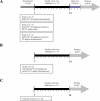Prevention of rectal SHIV transmission in macaques by daily or intermittent prophylaxis with emtricitabine and tenofovir
- PMID: 18254653
- PMCID: PMC2225435
- DOI: 10.1371/journal.pmed.0050028
Prevention of rectal SHIV transmission in macaques by daily or intermittent prophylaxis with emtricitabine and tenofovir
Abstract
Background: In the absence of an effective vaccine, HIV continues to spread globally, emphasizing the need for novel strategies to limit its transmission. Pre-exposure prophylaxis (PrEP) with antiretroviral drugs could prove to be an effective intervention strategy if highly efficacious and cost-effective PrEP modalities are identified. We evaluated daily and intermittent PrEP regimens of increasing antiviral activity in a macaque model that closely resembles human transmission.
Methods and findings: We used a repeat-exposure macaque model with 14 weekly rectal virus challenges. Three drug treatments were given once daily, each to a different group of six rhesus macaques. Group 1 was treated subcutaneously with a human-equivalent dose of emtricitabine (FTC), group 2 received orally the human-equivalent dosing of both FTC and tenofovir-disoproxil fumarate (TDF), and group 3 received subcutaneously a similar dosing of FTC and a higher dose of tenofovir. A fourth group of six rhesus macaques (group 4) received intermittently a PrEP regimen similar to group 3 only 2 h before and 24 h after each weekly virus challenge. Results were compared to 18 control macaques that did not receive any drug treatment. The risk of infection in macaques treated in groups 1 and 2 was 3.8- and 7.8-fold lower than in untreated macaques (p = 0.02 and p = 0.008, respectively). All six macaques in group 3 were protected. Breakthrough infections had blunted acute viremias; drug resistance was seen in two of six animals. All six animals in group 4 that received intermittent PrEP were protected.
Conclusions: This model suggests that single drugs for daily PrEP can be protective but a combination of antiretroviral drugs may be required to increase the level of protection. Short but potent intermittent PrEP can provide protection comparable to that of daily PrEP in this SHIV/macaque model. These findings support PrEP trials for HIV prevention in humans and identify promising PrEP modalities.
Conflict of interest statement
Figures




Comment in
-
Antiretroviral therapy for prevention of HIV infection: new clues from an animal model.PLoS Med. 2008 Feb;5(2):e30. doi: 10.1371/journal.pmed.0050030. PLoS Med. 2008. PMID: 18254655 Free PMC article. Review.
References
-
- Joint United Nations Programme on HIV/AIDS. 2007 AIDS Epidemic update. 2007. Available: http://www.unaids.org/en/KnowledgeCentre/HIVData/EpiUpdate/EpiUpdArchive.... - PubMed
-
- Cohen MS, Gay C, Kashuba AD, Blower S, Paxton L. Narrative review: Antiretroviral therapy to prevent the sexual transmission of HIV-1. Ann Intern Med. 2007;146:591–601. - PubMed
-
- Liu AY, Grant RM, Buchbinder SP. Preexposure prophylaxis for HIV. JAMA. 2006;296:863–865. - PubMed
-
- Grant RM, Buchbinder S, Cates W, Jr, Clarke E, Coates T, et al. Promote HIV chemoprophylaxis research, don't prevent it. Science. 2005;309:2170–2171. - PubMed
Publication types
MeSH terms
Substances
Grants and funding
LinkOut - more resources
Full Text Sources
Other Literature Sources
Medical
Miscellaneous

